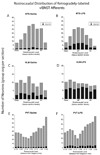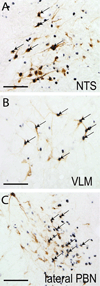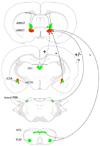Immune challenge activates neural inputs to the ventrolateral bed nucleus of the stria terminalis
- PMID: 21402087
- PMCID: PMC3118915
- DOI: 10.1016/j.physbeh.2011.03.006
Immune challenge activates neural inputs to the ventrolateral bed nucleus of the stria terminalis
Abstract
Hypothalamo-pituitary-adrenal (HPA) axis activation in response to infection is an important mechanism by which the nervous system can suppress inflammation. HPA output is controlled by the hypothalamic paraventricular nucleus (PVN). Previously, we determined that noradrenergic inputs to the PVN contribute to, but do not entirely account for, the ability of bacterial endotoxin (i.e., lipopolysacharide, LPS) to activate the HPA axis. The present study investigated LPS-induced recruitment of neural inputs to the ventrolateral bed nucleus of the stria terminalis (vlBNST). GABAergic projections from the vlBNST inhibit PVN neurons at the apex of the HPA axis; thus, we hypothesize that LPS treatment activates inhibitory inputs to the vlBNST to thereby "disinhibit" the PVN and increase HPA output. To test this hypothesis, retrograde neural tracer was iontophoretically delivered into the vlBNST of adult male rats to retrogradely label central sources of axonal input. After one week, rats were injected i.p. with either LPS (200 μg/kg BW) or saline vehicle, and then perfused with fixative 2.5h later. Brains were processed for immunohistochemical localization of retrograde tracer and the immediate-early gene product, Fos (a marker of neural activation). Brain regions that provide inhibitory input to the vlBNST (e.g., caudal nucleus of the solitary tract, central amygdala, dorsolateral BNST) were preferentially activated by LPS, whereas sources of excitatory input (e.g., paraventricular thalamus, medial prefrontal cortex) were not activated or were activated less robustly. These results suggest that LPS treatment recruits central neural systems that actively suppress vlBNST neural activity, thereby removing a potent source of inhibitory control over the HPA axis.
Copyright © 2011 Elsevier Inc. All rights reserved.
Figures






Similar articles
-
Noradrenergic inputs to the paraventricular hypothalamus contribute to hypothalamic-pituitary-adrenal axis and central Fos activation in rats after acute systemic endotoxin exposure.Neuroscience. 2008 Oct 28;156(4):1093-102. doi: 10.1016/j.neuroscience.2008.08.011. Epub 2008 Aug 13. Neuroscience. 2008. PMID: 18773942 Free PMC article.
-
Noradrenergic inputs to the bed nucleus of the stria terminalis and paraventricular nucleus of the hypothalamus underlie hypothalamic-pituitary-adrenal axis but not hypophagic or conditioned avoidance responses to systemic yohimbine.J Neurosci. 2006 Nov 1;26(44):11442-53. doi: 10.1523/JNEUROSCI.3561-06.2006. J Neurosci. 2006. PMID: 17079674 Free PMC article.
-
Organization of immune-responsive medullary projections to the bed nucleus of the stria terminalis, central amygdala, and paraventricular nucleus of the hypothalamus: evidence for parallel viscerosensory pathways in the rat brain.Brain Res. 2007 Jan 26;1130(1):130-45. doi: 10.1016/j.brainres.2006.10.084. Epub 2006 Dec 13. Brain Res. 2007. PMID: 17169348
-
Role of noradrenergic projections to the bed nucleus of the stria terminalis in the regulation of the hypothalamic-pituitary-adrenal axis.Brain Res Brain Res Rev. 2004 Dec;47(1-3):145-60. doi: 10.1016/j.brainresrev.2004.07.011. Brain Res Brain Res Rev. 2004. PMID: 15572169 Review.
-
Brain mechanisms of HPA axis regulation: neurocircuitry and feedback in context Richard Kvetnansky lecture.Stress. 2020 Nov;23(6):617-632. doi: 10.1080/10253890.2020.1859475. Epub 2020 Dec 21. Stress. 2020. PMID: 33345670 Free PMC article. Review.
Cited by
-
Psychogenic Stress Activates C-Fos in Nucleus Accumbens-Projecting Neurons of the Hippocampal Ventral Subiculum.Int J Neuropsychopharmacol. 2017 Oct 1;20(10):855-860. doi: 10.1093/ijnp/pyx054. Int J Neuropsychopharmacol. 2017. PMID: 28977522 Free PMC article.
-
The role of nucleus of the solitary tract glucagon-like peptide-1 and prolactin-releasing peptide neurons in stress: anatomy, physiology and cellular interactions.Br J Pharmacol. 2022 Feb;179(4):642-658. doi: 10.1111/bph.15576. Epub 2021 Jun 26. Br J Pharmacol. 2022. PMID: 34050926 Free PMC article. Review.
-
IL-6, but not TNF-α, response to alcohol cues and acute consumption associated with neural cue reactivity, craving, and future drinking in binge drinkers.Brain Behav Immun Health. 2023 Jun 11;31:100645. doi: 10.1016/j.bbih.2023.100645. eCollection 2023 Aug. Brain Behav Immun Health. 2023. PMID: 37484196 Free PMC article.
-
Amygdala β-noradrenergic receptors modulate delayed downregulation of dopamine activity following restraint.J Neurosci. 2013 Jan 23;33(4):1441-50. doi: 10.1523/JNEUROSCI.2420-12.2013. J Neurosci. 2013. PMID: 23345220 Free PMC article.
-
Influences of Stress and Sex on the Paraventricular Thalamus: Implications for Motivated Behavior.Front Behav Neurosci. 2021 Feb 26;15:636203. doi: 10.3389/fnbeh.2021.636203. eCollection 2021. Front Behav Neurosci. 2021. PMID: 33716683 Free PMC article.
References
-
- Buller KM. Circumventricular organs: gateways to the brain role of circumventricular organs in pro-inflammatory cytokine-induced activation of the hypothalamic- pituitary-adrenal axis. Clinical and Experimental Pharmacology and Physiology. 2001;28:581–589. - PubMed
-
- Vitkovic L, Konsman JP, Bockaert J, Dantzer R, Homburger V, Jacque C. Cytokine signals propagate through the brain. Molecular Psychiatry. 2000;5:604–615. - PubMed
-
- Goehler LE, Gaykema RPA. Neural pathways mediating behavioral changes associated with immunological challenge. In: Siegal A, Zalcman S, editors. The Neuroimmunological Basis of Behavior and Mental Disorders. 1st ed. New York: Springer; 2008.
Publication types
MeSH terms
Substances
Grants and funding
LinkOut - more resources
Full Text Sources
Miscellaneous

